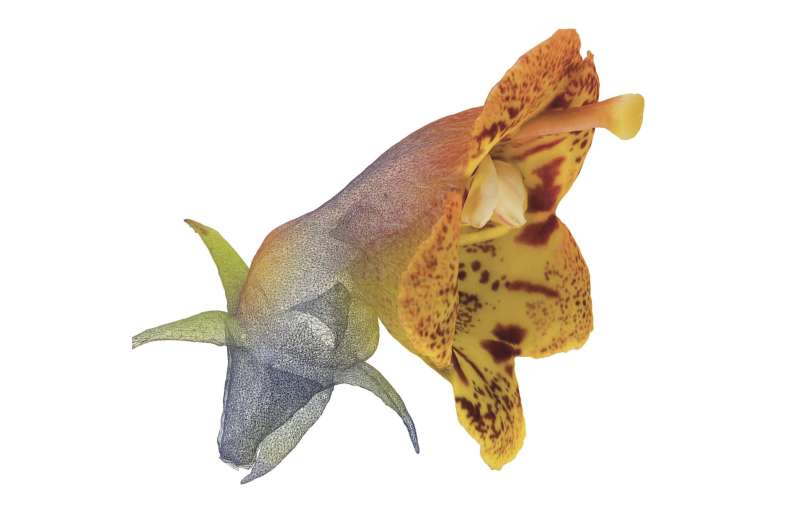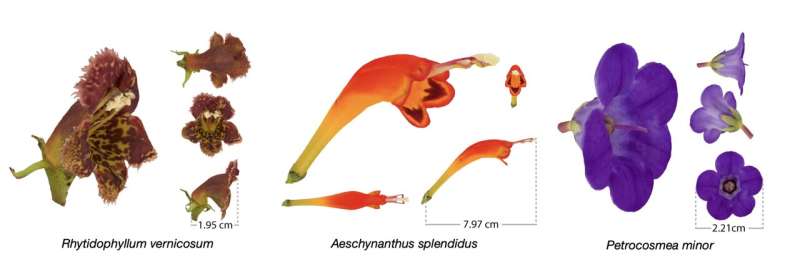Examining the three dimensions of a flower

To better understand the evolution of flowers, a research team in biology from Université de Montréal, the Montreal Botanical Garden and McGill University have succeeded in using photogrammetry to quickly and precisely build, in three dimensions, a model of a flower from two-dimensional images.
Photogrammetry is commonly used by geographers to reconstruct the topography of a landscape. However, this is the first time that scientists have used the technique to design 3D models of flowers in order to better study them.
They results of their experiment were published in October in the journal New Phytologist.
Photogrammetry is an approach based on information gathered from numerous photos taken from all angles. Thanks to the triangulation of common points present on the photos, it is possible to reconstruct a 3D model—in this case, of a flower. Colors can then be applied to the 3D flower using information from the photos.
Attracting pollinators by shape and color
Flowers are complex and extremely varied three-dimensional structures. Characterizing their forms is important in order to understand their development, functioning and evolution. Indeed, 91 percent of flowering plants interact with pollinators to ensure their reproduction in a 3D environment. The morphology and colors of the flowers act like magnets on pollinators in order to attract them. Yet the 3D structure of flowers is rarely studied.
The use of photogrammetry has real advantages compared to other existing methods, in particular X-ray microtomography, which is by far the most widely used method to build 3D flower models.
"Photogrammetry is much more accessible, since it's cheap, requires little specialized equipment and can even be used directly in nature," said Marion Leménager, a doctoral student in biological sciences at UdeM and lead author of the study. "In addition, photogrammetry has the advantage of reproducing the colors of flowers, which is not possible with methods using X-rays."

It was Daniel Schoen, a McGill biology professor, who first had the idea of applying photogrammetry to flowers, while doing research at Institut de recherche en biologie végétale. The first results, although imperfect, were enough to convince Leménager to devote a chapter of her thesis to it.
"The method is not perfect," she said. "Some parts of the flowers remain difficult to reconstruct in 3D, such as reflective, translucent or very hairy surfaces."
Answering questions on flowers' evolution
"That said," added UdeM biology professor Simon Joly, "thanks to the living collections of the Montreal Botanical Garden, the study of plants of the Gesneriaceae family—plants originating from subtropical to tropical regions, of which the African violet is one of the best known representatives—demonstrates that 3D models produced using this technique make it possible to explore a large number of questions on the evolution of the shape and color of flowers.
"We have also shown that photogrammetry works at least as well as X-ray methods for visible flower structures," said Joly, who conducts research at the Botanical Garden.
Photogrammetry has the potential to boost research on flower evolution and ecology by providing a simple way to access three-dimensional morphological data, the researchers believe. Databases of flowers—or even of complete plants—could give scientists and the general public a way to see the unique features of plant species that for now remain hidden.
An open-access, detailed protocol has been made available to promote the use of this method in the context of the comparative study of floral morphology. The goal of free access to natural science collections of this sort is to help stimulate the study of the evolution of flower morphology at large taxonomic, temporal and geographical scales.
It is also possible to admire flower models from every angle thanks to a 3D model viewer.
More information: Marion Leménager et al, Studying flowers in 3D using photogrammetry, New Phytologist (2022). DOI: 10.1111/nph.18553
3D model viewer: sketchfab.com/3d-models/rhytid … 40bf8cdae3f88777ffe4
Journal information: New Phytologist
Provided by University of Montreal




















